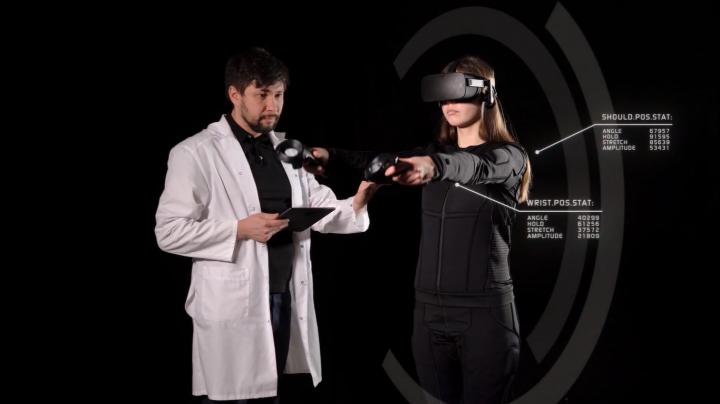
Credit: FEFU press office
Scientists from Far Eastern Federal University (FEFU) together with leading international experts suggest reconsidering the existing treatment protocol for severe spasticity, one of the main complications after spinal cord injury with partial spinal cord disruption. Spasticity aggravates a patient’s state and dramatically reduces the prospects of rehabilitation. The new treatment protocol has been run at FEFU Medical Center. A related article was published in the Progress in Brain Research journal.
A team from FEFU developed a protocol helping to learn the eligibility of disabled patients with spinal cord trauma and severe spasticity for the implantation of a spinal cord stimulator or an Intrathecal Baclofen infusion pump. For the first time, these alternative methodologies were compared in two experimental groups.
The team suggest subjecting patients to 3-5 days long preliminary experimental spinal cord stimulation before approving them for surgery. If no response to the impulses of current is registered, a patient needs to be tested for their reaction to Baclofen. This important step helps both the patient and their doctor make an informed decision about the type of surgery.
According to the team, 12 months after the surgery the state of the patients in both groups improved considerably related to the control group. Moreover, patients with implanted Baclofen infusion pumps showed improved motor functions. However, the team still believes spinal cord stimulation (SCS) to be a prospective therapeutic method and suggests reconsidering existing international practices of treating patients with severe spinal cord trauma.
“Over 800 thousand people suffer from concomitant spine injuries with spinal cord transection every year. Only one out of three patients survives this severe condition. The survivors are often 20 to 25 years old. Sadly, they usually stay disabled for the rest of their lives. 80% of the patients develop spastic syndrome that dramatically reduces the prospects of rehabilitation and causes severe complications. Intrathecal Baclofen Therapy (IBT) is the most popular type of treatment for these patients. A pump implanted into a patient’s body delivers Baclofen directly to the spinal cord thus reducing the muscle tone. However, this method is associated with many risks and complications, and more importantly, it makes a patient forever dependent on Baclofen treatment and deprives them of any hope of improvement,” explained Igor Bryukhovetskiy, the Head of the Laboratory of Molecular and Cellular Neurobiology, Department of Fundamental Medicine of the School of Biomedicine at FEFU.
SCS, or electrical neuromodulation of the spinal cord with a small implanted stimulator, is the next step to approach the issues of verticalization and motor rehabilitation of patients after severe spinal trauma. This type of surgery gives paralyzed patients the biggest chances for maximum future rehabilitation.
After the surgery, a stimulator begins to send signals to electrodes implanted in the spinal cord which helps activate the neuronal circuits below the injured area. The circuits regain their ability to receive commands from the brain and to activate the neurons that move the leg muscles.
“Statistically, complete spinal cord neurotmesis or disruption happens quite rarely, while partial allows for a certain degree of recovery. In the first and second years of treatment, the main methods are systematic neuroprotection and regenerative therapy, specifically, with the use of biomedical cell products. These methods can help considerably improve a patient’s neurological functions. However, the therapy of spastic syndrome requires a completely different approach. To solve this issue, we suggest implanting a spinal cord stimulation system that can reduce spasticity by means of suppressing pathological impulses in the spinal cord with electric current,” says Artur Biktimirov, a co-author of the work, a neurosurgeon at FEFU Medical Center, and an analyst at the FEFU National Technological Initiative Center.
According to him, patients with complete spinal cord neurotmesis have very limited rehabilitation potential. However, SCS opens new prospects for motor neurorehabilitation even at the stages when other methods fail.
The study is based on the results of the treatment of 66 patients of FEFU Medical Center. The patients were 18 to 62 years of age (36 on average), suffered from spinal cord trauma and severe spasticity, and were paralyzed below the injury level. Based on the outcome of preliminary testing, the first group of 18 patients underwent the implanting of SCS devices, while the second group (15 patients) received Baclofen pumps. The rest of the patients preferred conservative treatment to surgery and consent to form a control group.
The neuromodulation method is being developed by the FEFU School of Biomedicine, and the FEFU National Technological Initiative Center for Neurotechnology, VR, and AR in collaboration with leading Russian and international experts.
###
The study was supported by FEFU with the grant “Neurotechnology, VR, and AR). See also: Agreement No. 2/1251/2019 between the NIT Fund (founded by the Russian Venture Company) and FEFU dd. 05.08.2019; Agreement on Granting Subsidies for State Support of NIT Centers No.0000000007518P240002.
Media Contact
Alexander Zverev
[email protected]
Related Journal Article
http://dx.
https://scienmag.com/fefu-scientists-suggest-using-neuromodulation-to-treat-patients-with-spinal-cord-injuries/




